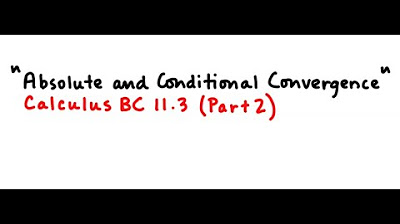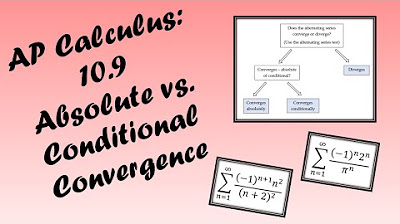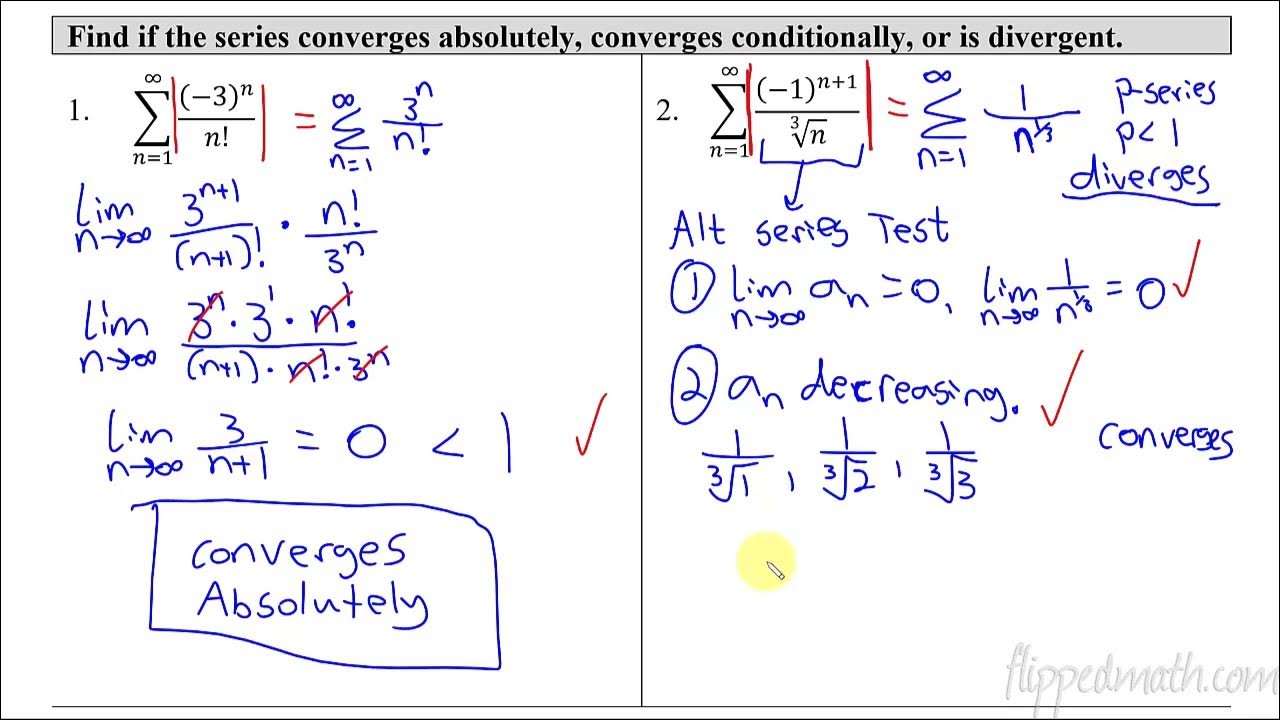Calculus 2 Lecture 9.6: Absolute Convergence, Ratio Test and Root Test For Series
TLDRThis video script delves into the concept of absolute convergence in series analysis. It explains how to handle series with negative terms when traditional tests like the integral or comparison tests are inapplicable. The script introduces the ratio test and root test, illustrating their application with examples. It emphasizes the importance of absolute convergence as a stronger condition than conditional convergence. The tutorial aims to equip viewers with the tools to determine whether a series is absolutely convergent, conditionally convergent, or divergent, providing a comprehensive overview of series testing techniques.
Takeaways
- 📚 The video discusses various tests for the convergence of series, including the Integral Test, Comparison Test, Limit Comparison Test, Alternating Series Test, Ratio Test, and Root Test.
- 🔍 The Integral Test is applicable for positive, continuous, and decreasing functions on an interval from a certain point to infinity, and it can determine if the series converges or diverges by comparing it to the integral of the function.
- ⚖️ The Comparison Test and Limit Comparison Test are used to compare the given series with a known series to determine convergence or divergence based on the relationship between their terms.
- 🔄 The Alternating Series Test is used for series with terms that alternate in sign and requires the limit of the term to be zero and the terms to be decreasing in absolute value.
- 📉 The Ratio Test involves taking the limit of the ratio of consecutive terms of the series and can determine absolute convergence, divergence, or inconclusive results based on whether the limit is less than, greater than, or equal to one.
- 📏 The Root Test is used to determine the convergence of a series by taking the limit of the nth root of the absolute value of the terms, and it can also result in absolute convergence, divergence, or inconclusive results.
- 🔢 The video emphasizes the importance of recognizing the type of series and applying the most suitable test, such as using the Ratio Test for series with factorials or nth powers.
- 📌 The script provides examples and explanations for each test, illustrating how to apply them to different series and interpret the results.
- 📝 The presenter suggests starting with the Divergence Test for any series and then proceeding to other tests if necessary, highlighting a systematic approach to analyzing series convergence.
- 🛑 The video clarifies that certain tests are not suitable for all types of series, such as avoiding the Root Test for series with factorials and instead using the Ratio Test.
- 🔑 The key takeaway is that understanding the properties of the series and choosing the appropriate test is crucial for determining convergence, with absolute convergence being the strongest form of convergence.
Q & A
What is the main topic discussed in section 9.6 of the transcript?
-The main topic discussed in section 9.6 is absolute convergence, including how to deal with negative terms in a series when they do not alternate, and the concept of absolute convergence in series testing.
What is an alternating series test?
-An alternating series test is a method used to determine the convergence of a series that alternates between positive and negative terms, such as (-1)^n * (1/n), where the terms decrease in magnitude.
What is absolute convergence and why is it significant?
-Absolute convergence is a property of a series where the series formed by taking the absolute value of each term of the original series also converges. It is significant because if a series is absolutely convergent, it is guaranteed to be convergent, making it a stronger condition than simple convergence.
What is the ratio test and when should it be used?
-The ratio test is a method to determine the convergence of a series by examining the limit of the ratio of consecutive terms. It should be used when dealing with factorials or powers of n in the series, as it can effectively show absolute convergence or divergence.
What is the root test and how does it differ from the ratio test?
-The root test is another method to determine the convergence of a series by taking the limit of the nth root of the absolute value of its terms. Unlike the ratio test, which involves a ratio of consecutive terms, the root test focuses on the root of each term's absolute value.
Can a series be both conditionally convergent and absolutely convergent?
-No, a series cannot be both conditionally convergent and absolutely convergent. A series is either divergent, conditionally convergent (converges but not absolutely), or absolutely convergent (strongest form of convergence).
What is the difference between a series being convergent and being absolutely convergent?
-A series is convergent if the sum of its terms approaches a finite limit. A series is absolutely convergent if the sum of the absolute values of its terms also approaches a finite limit. Absolute convergence implies convergence, but the converse is not necessarily true.
How does the ratio test provide information about the convergence of a series?
-The ratio test provides information about the convergence of a series by examining the limit of the absolute value of the ratio of consecutive terms. If the limit is less than one, the series is absolutely convergent. If the limit is greater than one, the series is divergent. If the limit equals one, the test is inconclusive.
What is the condition for a geometric series to be convergent according to the transcript?
-A geometric series is convergent if the absolute value of its common ratio (R) is less than one. If the absolute value of R is greater than or equal to one, the series is divergent.
What is the significance of the limit of the ratio of consecutive terms in the ratio test?
-In the ratio test, the limit of the absolute value of the ratio of consecutive terms determines the convergence of the series. If this limit is less than one, the series is absolutely convergent. If it is greater than one, the series is divergent. An inconclusive result occurs if the limit equals one, requiring further testing.
Outlines
📚 Introduction to Absolute Convergence
This paragraph introduces the concept of absolute convergence in series analysis. It discusses how to handle negative terms in series testing, emphasizing that while tests like the integral and comparison tests require positive terms, absolute convergence allows for negative terms by considering the absolute value of the series. The speaker promises to explain absolute convergence, its application, and two powerful tests based on this concept, one of which is the ratio test. An example of a series that does not alternate and is not always positive or decreasing is mentioned, setting the stage for the explanation of absolute convergence.
🔍 Exploring Absolute Convergence with Examples
The speaker delves into absolute convergence by providing examples and explaining how it differs from simple convergence. They illustrate how taking the absolute value of a series can lead to a new series that, if convergent, implies the original series is absolutely convergent. The concept is clarified using the series of 1/n^2, which is shown to be absolutely convergent. The importance of absolute convergence is highlighted by demonstrating that a series can be convergent but not absolutely convergent, as seen with the alternating harmonic series, leading to the concept of conditional convergence.
📉 Understanding Conditionally Convergent Series
This section clarifies the difference between absolutely convergent and conditionally convergent series. The speaker uses the alternating harmonic series as an example to explain that a series can be convergent without being absolutely convergent. They emphasize that absolute convergence is a stronger condition than simple convergence, and that any absolutely convergent series is guaranteed to be convergent. The concept is reinforced by discussing the implications of the absolute value on the convergence of a series.
📌 Applying Absolute Convergence to Series Analysis
The speaker discusses the application of absolute convergence in series analysis, specifically mentioning the series of sin(2n)/n^2 as an example. They explain that absolute convergence can be tested by examining the convergence of the series formed by taking the absolute value of the original series' terms. The comparison with the p-series is made, and the convergence of the series with the absolute value is used to infer the absolute convergence of the original series.
📚 Introduction to the Ratio Test
The paragraph introduces the ratio test, a powerful tool for series analysis. The test involves forming a ratio of consecutive terms of a sequence and taking the limit as n approaches infinity. The speaker outlines the outcomes of the ratio test: if the limit is less than one, the series is absolutely convergent; if greater than one, the series is divergent; and if equal to one, the test is inconclusive. An example is briefly mentioned to illustrate the application of the ratio test.
🔍 Demonstrating the Ratio Test with Examples
The speaker provides a detailed walkthrough of the ratio test using specific examples. They show how to calculate the limit of the ratio of consecutive terms and interpret the results to determine the convergence or divergence of a series. The examples illustrate how the ratio test can be used to establish absolute convergence or divergence, and the speaker emphasizes the test's utility in series analysis.
📉 Analyzing Series Convergence Using the Ratio Test
This section focuses on applying the ratio test to determine the convergence of various series. The speaker demonstrates how the test can be used to identify absolute convergence or divergence and how it simplifies the analysis of series with factorials and powers of n. The examples provided show the step-by-step process of using the ratio test and highlight its effectiveness as a 'goto' test for series analysis.
📌 Conclusion and Recap of Series Analysis Techniques
The speaker concludes the discussion by summarizing the various tests and techniques used in series analysis. They provide a recap of the divergence test, geometric series test, telescoping series test, p-series test, and the integral test. The speaker also outlines the conditions under which each test is applicable and emphasizes the importance of selecting the appropriate test based on the characteristics of the series in question.
📚 Overview of Series Analysis Strategies
This paragraph offers an overview of strategies for analyzing series convergence. The speaker suggests starting with the divergence test for all series and then considering the specific type of series, such as geometric, telescoping, or p-series. They also mention the integral test for functions that are positive, continuous, and decreasing. The speaker emphasizes the importance of understanding the characteristics of the series to choose the most efficient test.
📌 Applying the Comparison and Limit Comparison Tests
The speaker discusses the comparison test and the limit comparison test for series analysis. They explain that these tests involve comparing the given series with a known series or taking the limit of the ratio of the terms of two series. The outcomes of these tests can help determine the convergence or divergence of the series in question, especially when the series terms are similar to those of a known series.
📉 Utilizing the Alternating Series Test
The paragraph focuses on the alternating series test, which is applicable when the series terms alternate in sign. The speaker outlines the two-part test: the limit of the first term must be zero, and the terms must be decreasing. If these conditions are met, the series is considered convergent.
📚 Choosing the Right Test for Series Analysis
The speaker provides guidance on choosing the appropriate test for series analysis based on the properties of the series. They discuss the ratio test for factorials and powers of n, and the root test for n powers. The speaker also emphasizes the importance of recognizing when to use the ratio test or the root test, and when to apply the comparison or limit comparison tests.
📌 Summary of Series Analysis Techniques
The speaker summarizes the series analysis techniques, providing a quick rundown of the tests and their applications. They highlight the divergence test, geometric and telescoping series tests, p-series test, integral test, comparison and limit comparison tests, alternating series test, ratio test, and root test. The speaker aims to ensure that the audience has a clear understanding of when and how to apply each test.
Mindmap
Keywords
💡Absolute Convergence
💡Series Test
💡Ratio Test
💡Root Test
💡Conditional Convergence
💡Alternating Series Test
💡Harmonic Series
💡Divergence Test
💡Geometric Series
💡Telescoping Series
Highlights
Introduction to absolute convergence and its significance in series testing.
Explanation of how to handle negative terms in series through absolute convergence.
Absolute convergence demonstrated as a stronger condition than conditional convergence.
Illustration of the difference between convergent and absolutely convergent series using examples.
The ratio test explained as a powerful method for determining series convergence.
Detailed walkthrough of applying the ratio test to alternating series.
Clarification on when the ratio test is conclusive and when it requires further analysis.
Use of absolute values in simplifying series for testing purposes.
The root test introduced as an alternative to the ratio test for series with nth powers.
Step-by-step application of the root test to determine series convergence.
Comparison of the root test and ratio test, including when to use each.
Strategy for choosing the appropriate test for a given series based on its characteristics.
Summary of series tests, including divergence, geometric, telescoping, and p-series tests.
Guidance on applying the integral test for series with positive continuous and decreasing functions.
Comparison and limit comparison tests explained for series with positive terms.
Alternating series test outlined, including conditions for convergence.
Final summary and strategy guide for selecting the optimal test for a series based on its properties.
Transcripts
Browse More Related Video

Absolute and Conditional Convergence

Calculus Chapter 5 Lecture 53 Absolute & Conditional

AP Calculus BC Lesson 10.9

Alternating Series, Types of Convergence, and the Ratio Test

Calculus 2 - Geometric Series, P-Series, Ratio Test, Root Test, Alternating Series, Integral Test

Calculus BC – 10.9 Determining Absolute or Conditional Convergence
5.0 / 5 (0 votes)
Thanks for rating: